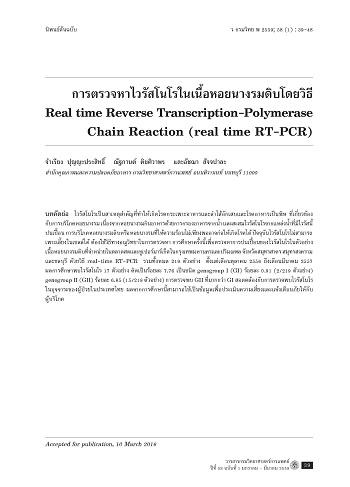Detection of Norovirus in Raw oyster meat by using Real Time Reverse Transcription-Polymerase Chain Reaction (Real Time RT-PCR)
Keywords:
detection, norovirus, raw oyster meat, real time RT-PCRAbstract
Norovirus is an important causative agent of gastroenteritis and food poisoning associated with oyster consumption. Because of its filter feeder, oysters can accumulate norovirus from growing water contaminated with norovirus. Consumption of raw or undercooked oysters may cause illness. Norovirus cannot be cultivated to date, thus detection relies on molecular method. This study was undertaken to investigate norovirus in raw oyster meat from fresh markets and supermarkets in Bangkok and peripheral areas, Samut Sakhon, Samut Songkhram and Chon Buri province, between October 2013 to March 2014, by using real-time RT-PCR method. The results showed that norovirus was detected in 17 out of 219 samples (7.76%), of which two samples (0.91%) belonged to genogroup I (GI) and 15 samples (6.85%) belonged to genogroup II (GII). The detection of higher incidence of GII over GI is relevant to the trend of incidence of norovirus in feces of Thai patients. This data can be used to evaluate risks and to inform national health alert to consumers.
References
Koo HL, Ajami N, Atmar RL, DuPont HL. Noroviruses: the principal cause of foodborne disease worldwide. Discov Med 2010; 10(50): 61-70.
Gibson KE, Ricke SC. Human noroviruses and food safety. Agric Food Anal Bacteriol 2012; 2(1): 25-34.
อภิรดี เทียมบุญเลิศ, ทวีศักดิ์ เชี่ยวชาญศิลป์ และยง ภู่วรวรรณ. ท้องเสียจากไวรัส. ว กุมารเวชศาสตร์ 2555; 55(2): 84-90
Centers for Disease Control and Prevention (CDC). Updated norovirus outbreak management and disease prevention guideline. MMWR 2011; 60(3): 1-15.
Centers for Disease Control and Prevention (CDC). Emergence of new norovirus strain GII.4 Sydney- United States, 2012. MMWR 2013; 62(3): 55.
FAO/WHO. Viruses in food: scientific advice to support risk management activities, meeting report. Microbiological risk assessment series 13. Geneva: FAO and WHO; 2008.
Bellou M, Kokkinos P, Vantarakis A. Shellfish-borne viral outbreaks: a systematic review. Food Environ Virol 2013; 5(1): 13-23.
Webby RJ, Carville KS, Kirk MD, Greening G, Ratcliff RM, Crerar SK, et al. Internationally distributed frozen oyster meat causing multiple outbreaks of norovirus infection in Australia. Clin Infect Dis 2007; 44(8): 1026-31.
Alfano-Sobsey E, Sweat D, Hall A, Breedlove F, Rodriguez R, Greene S, et al. Norovirus outbreak associated with undercooked oysters and secondary household transmission. Epidemiol Infect 2012; 140(2): 276-82.
McIntyre L, Galanis E, Mattison K, Mykytczuk O, Buenaventura E, Wong J, et al. Multiple clusters of norovirus among shellfish consumers linked to symptomatic oyster harvesters. J Food Prot 2012; 75(9): 1715-20.
Atmar RL. Noroviruses - state of the art. Food Environ Virol 2010; 2(3): 117-26.
CAC/GL 79-2012. Guideline on the application of general principles of food hygiene to the control of viruses in food [online]. 2012 [cited 2015 Jun 23]; [13 screens]. Available from: URL: https://www.fao.org/fao-who-codexalimentarius/download/standards/13215/CXG_079e.pdf
ISO/TS 15216-2:2013. Microbiology of food and animal feed - Horizontal method for determination of hepatitis A virus and norovirus in food using real-time RT-PCR - Part 2: method for qualitative detection. Geneva, Switzerland: ISO; 2013.
Infection Agents Surveillance Report (IASR). Norovirus food poisoning in Japan as of 2011 [online]. 2011 Dec [cited 2015 Jun 23]; 32(12). Available from: URL: https://www.nih.go.jp/niid/en/iasr-e.html
Maalouf H, Schaeffer J, Parnaudeau S, Le Pendu J, Atmar RL, Crawford SE, et al. Strain-dependent norovirus bioaccumulation in oysters. Appl Environ Microbiol 2011; 77(10): 3189-96.
Schrader C, Schielke A, Ellerbroek L, Johne R. PCR inhibitors-occurrence, properties and removal. J Appl Microbiol 2012; 113(5): 1014-26.
Stals A, Baert L, Coillie EV, Uyttendaele M. Extraction of food-borne viruses from food samples: a review. Int J Food Microbiol 2012; 153(1-2): 1-9.
Uhrbrand K, Myrmel M, Maunula L, Vainio K, Trebbien R, Norrung B, et al. Evaluation of a rapid method for recovery of norovirus and hepatitis A virus from oysters and blue mussels. J Virol Methods 2010; 169(1): 70-8.
Rajko-Nenow P, Waters A, Keaveney S, Flannery J, Tuite G, Coughlan S, et al. Norovirus genotypes present in oysters and in effluent from a wastewater treatment plant during in seasonal peak of infections in Ireland in 2010. Appl Environ Microbiol 2013; 79(8): 2578-87.
EFSA Panel of Biological Hazards (BIOHAZ). Scientific opinion on norovirus (NoV) in oysters: methods, limits and control options. EFSA J 2012; 10(1): 2500.
Schaeffer J, Le Saux JC, Lora M, Atmar RL, Le Guyader FS. Norovirus contamination on French marketed oysters. Int J Food Microbiol 2013; 166(2): 244-8.
Woods JW, Burkhardt W. Occurrence of norovirus and hepatitis A virus in U.S. oysters. Food Environ Virol 2010; 2(3): 176-82.
Ma LP, Zhao F, Yao L, Li XG, Zhou DQ, Zhang RL. The presence of genogroup II norovirus in retail shellfish from seven coastal cities in China. Food Environ Virol 2013; 5(2): 81-6.
Nishida T, Kimura H, Saitoh M, Shinohara M, Kato M, Fukuda S, et al. Detection, quantitation and phylogenetic analysis of noroviruses in Japanese oysters. Appl Environ Microbiol 2003; 69(10): 5782-6.
Brake F, Ross T, Holds G, Kiermeier A, McLeod C. A survey of Australian oysters for the presence of human noroviruses. Food Microbiol 2014; 44: 264-70.
Chaimongkol N, Khamrin P, Malasao R, Thongprachum A, Kongsricharoern T, Ukarapol N, et al. Molecular characterization of norovirus variants and genetic diversity of noroviruses and sapoviruses in Thailand. J Med Virol 2014; 86(7): 1210-8.
Atmar RL, Opekun AR, Gilger MA, Estes MK, Crawford SE, Neill FH, et al. Norwalk virus shedding after experimental human infection. Emerg Infect Dis 2008; 14(10): 1553-7.
Love DC, Lovelace GL, Sobsey MD. Removal of Escherichia coli, Enterococcus fecalis, coliphage MS2, poliovirus and hepatitis A virus from oysters (Crassostrea virginica) and hard shell clams (Mercinaria mercinaria) by depuration. Int J Food Microbiol 2010; 143(3): 211-7.
Flannery J, Rajko-Nenow P, Keaveney S, O’Flaherty V, Dore W. Simulated sunlight inactivation of norovirus and FRNA bacteriophage in seawater. J Appl Microbiol 2013; 115(3): 915-22.
Morillo SG, Timenetsky Mdo C. Norovirus: an overview. Rev Assoc Med Bras 2011; 57(4): 453-8.

Downloads
Published
How to Cite
Issue
Section
License

This work is licensed under a Creative Commons Attribution-NonCommercial-NoDerivatives 4.0 International License.



